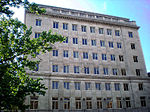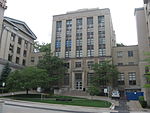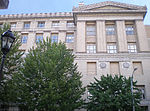Gardner Steel Conference Center

Gardner Steel Conference Center (GSCC) is an academic building of the University of Pittsburgh and a contributing property to the Schenley Farms National Historic District and a Pittsburgh History and Landmarks Foundation Historic Landmark.An Early Modern structure built from 1911-1912 by architects Kiehnel and Elliott, has been noted for its capital ornamentation over the entrance doors, and the wave-like shapes repeated across the cornice which likely derive from the German art nouveau movement jugendstil. The building originally served as the Central Turnverein, a German-American social and athletic association, and later known as the Central Athletic Association. It served as the site of various athletic contests, including some involving the University of Pittsburgh. During World War I, it was used to house those in the Student Army Training Corps. Following the war, a severe space shortage at the Dental School prompted the university to purchase the building in 1920 for use as a dental clinic and infirmary. Known then as the Infirmary Building, a 2,500-square-foot (230 m2) annex was erected in 1922 creating enough space in the building to hold 200 dental chairs.The Gardner Steel Conference Center, as it is now known, is currently home to classrooms, computer labs, the Academic Resource Center, and the Innovation Institute. In 1995, the School of Engineering and the Department of Mathematics collaborated on a $250,000 joint project that created a 2,300-square-foot (210 m2) laboratory for the computer instruction of calculus. The Gardner Steel Conference Center is the former home to the Pitt Club, a University of Pittsburgh faculty and staff club defunct since 2003. Previously, it also served for a time as home of the General Alumni Association (now the Pitt Alumni Association based in Alumni Hall).The Gardner Steel Conference Center is named after Gardner Steele, a Pitt alumnus and investor in the oil fields of Oklahoma. He matriculated in 1891 and was a member of one of the first intervarsity football teams and also held the record for the 100-yard (91 m) dash while at Pitt. When he died in 1928, he left the bulk of a $300,000 estate to the university.
Excerpt from the Wikipedia article Gardner Steel Conference Center (License: CC BY-SA 3.0, Authors, Images).Gardner Steel Conference Center
Fifth Avenue, Pittsburgh
Geographical coordinates (GPS) Address Website Nearby Places Show on map
Geographical coordinates (GPS)
| Latitude | Longitude |
|---|---|
| N 40.4445 ° | E -79.957752777778 ° |
Address
University of Pittsburgh (Pitt)
Fifth Avenue 4200
15260 Pittsburgh
Pennsylvania, United States
Open on Google Maps









